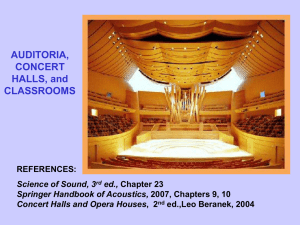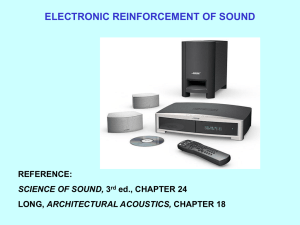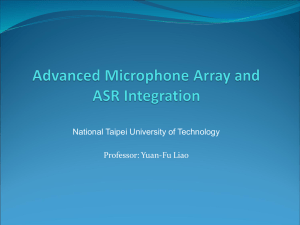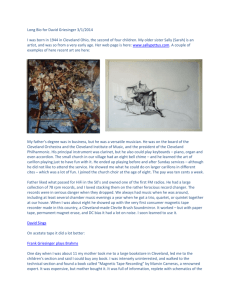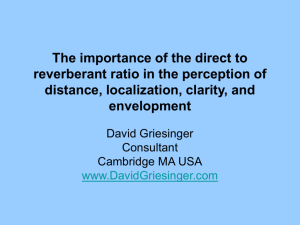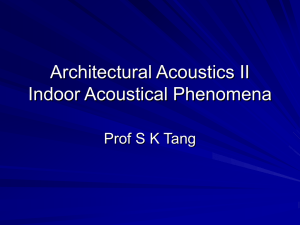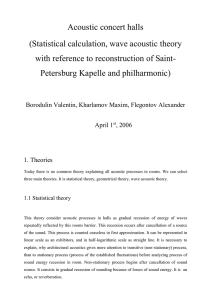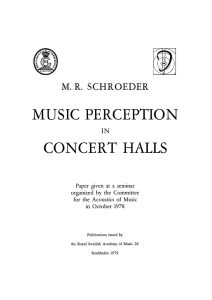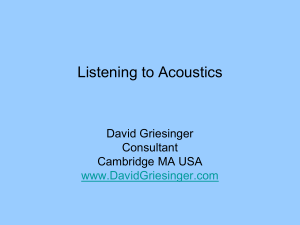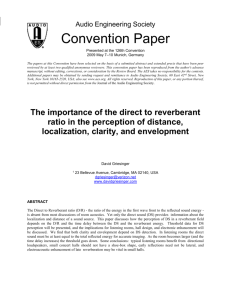Auditorium & Concert Hall Acoustics: Sound Reinforcement
advertisement
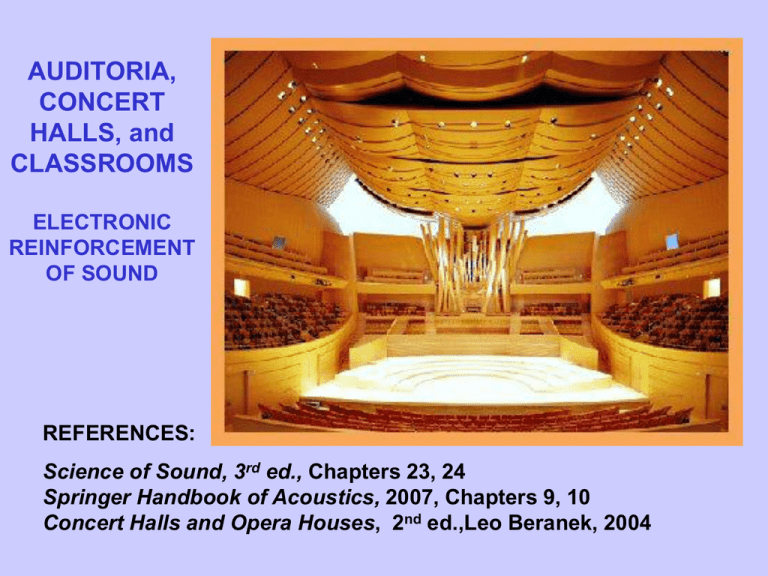
AUDITORIA, CONCERT HALLS, and CLASSROOMS ELECTRONIC REINFORCEMENT OF SOUND REFERENCES: Science of Sound, 3rd ed., Chapters 23, 24 Springer Handbook of Acoustics, 2007, Chapters 9, 10 Concert Halls and Opera Houses, 2nd ed.,Leo Beranek, 2004 SOUND FIELD OUTDOORS AND INDOORS p vs r Free field Reflections log p vs log r DIRECT AND EARLY SOUND Sound travels at 343 m/s. The direct sound reaches the listener in 20 to 200 ms, depending on the distance from the source to the listener. A short time later the same sound reaches the listener from various reflecting surfaces, mainly the walls and the ceiling. The first group of reflections, reaching the listener within about 50 to 80 ms, is often called the early sound. Early reflections from side walls are not equivalent to early reflections from the ceiling or from overhead reflectors. If the total energy from lateral reflections is greater than the energy from overhead reflection, the hall takes a desirable “spatial impression.” PRECEDENCE EFFECT Rather remarkably, our auditory processor deduces the direction of the sound source from the first sound that reaches our ears, ignoring reflections. This is called the precedence effect or “law of the first wavefront.” The source is perceived to be in the direction from which the first sound arrives provided that: 1. Successive sound arrives with 35 ms; 2. Successive sound have spectra and envelopes similar to the first sound; 3. Successive sounds are not too much louder than the first sound. GROWTH AND DECAY OF REVERBERANT SOUND SOUND SOURCE SOUND AT LISTENER GROWTH AND DECAY OF REVERBERANT SOUND SOUND SOURCE SOUND AT LISTENER RT = K (volume / area) RT = 0.161 V/A (V in m3; A in m2 ) If room dimensions are given in feet, the formula may be written: RT= 0.049 V/A (V in ft.3 ; A in ft.2 ) Sound decay Sound decay in a 400 m3 classroom Sound pressure level as a function of time for that room DECAY OF REVERBERANT SOUND CALCULATING REVERBERATION TIME CALCULATING REVERBERATION TIME CRITERIA FOR GOOD ACOUSTICS ●Adequate loudness ●Uniformity ●Clarity ●Right amount of reverberance ●Freedom from echoes ●Low level of background noise Desirable reverberation times for various sizes and functions Variation of reverberation time with frequency in good halls Avery Fisher Hall (New York) (2742 seats) McDermott Concert Hall (Dallas) (2065 seats) Orchestra Hall (Chicago) (2582 seats) Meyerhof Symphony Hall (Baltimore) (2467 seats) Walt Disney Concert Hall Disney (2265 seats, opened 2003) BING CONCERT HALL (Stanford) 844 seats, opened in January 2013 Named in honor of Helen and Peter Bing, major donors Kimmel Center Auditorium (Philadelphia) Verizon Hall: 2500 seats BACKGROUND NOISE CRITERIA Important criteria for concert halls: •Spatial impression •Intimacy •Early decay time •Clarity •“Warmth” Concert halls throughout the World CHURCHES Churches and synagogues are not primarily concert halls, but they share many of the same requirements for good acoustics. Old cathedrals have long reverberation times, and the spoken word was not as important as in contemporary worship. Much organ music was composed for these spaces. Background noise should be very low. Electronic reinforcement of sound should be used only when necessary CLASSROOMS Need for good acoustics: Students must be able to understand the teacher and each other. Must control: • Reverberation • Heating, ventilation, and air conditioning noise • Noise from outside the classroom ANSI standards: NC-25 to NC-30 WALLS AND NOISE BARRIERS The transmission coefficient is the ratio of transmitted to incident intensity: τ = IT/I0 and the transmission loss is: TL = -10 log τ. At low frequency, the sound transmission loss follows a mass law, increasing with increasing frequency and mass density M of the wall: Transmission loss for a wall may fall below that predicted by the mass law, due to any of the following: 1. Wall resonances 2. Excitation of bending waves at the critical frequency where they travel at the same speed as certain sound waves in air 3. Leakage of sound through holes and cracks TRANSMISSION LOSS THE EFFECT OF A HOLE ON TRANSMISSION LOSS ELECTRONIC REINFORCEMENT OF SOUND Ref: Science of Sound, Chapter 24 In a free field (away from reflecting surfaces), the sound pressure level at a distance r meters from the source is: SOUND FIELDS POWER CONSIDERATIONS LOUDSPEAKERS DYNAMIC LOUDSPEAKER HORN LOUDSPEAKER MULTIPLE SPEAKERS IN A CABINET HORN CLUSTERS LOUDSPEAKER SYSTEMS SINGLE CLUSTER—Maintains proper relationship between the sound system and the apparent source MULTIPLE CLUSTERS—Provides good covderage but spreads the apparent source COLUMN MOUNTED---Susceptable to interference effects DISTRIBUTED—Should include time delay to maintain proper relationship with direct sound PEWBACK SYSTEMS—Provides good coverage in churches TIME DELAY Sound that arrives up to 50 ms after the direct sound will reinforce the direct sound and yet preserve the apparent direction of the sound source. Time delay is especially important in the case of supplementary speakers positioned in problem areas, such as undereneath a balcony, or for speakers mounted on the side walls LOUDSPEAKER PLACEMENT LOUDSPEAKER DIRECTIVITY UNSATISFACTORY ARRANGEMENT OF LOUDSPEAKERS RADIATION PATTERN AND DIRECTIVITY FACTOR Q FOR A TYPICAL 8-INCH CONE LOUDSPEAKER ACOUSTIC FEEDBACK EQUALIZATION ENHANCEMENT OF REVERBERATION Adjustment of reverberation time is desirable in multipurpose halls. Maximum clarity of speech demands a short reverberation time, but a pipe organ sounds best in a reverberant room. One solution the use of electronicallyenhanced reverberation or “assisted resonance.” One method of enhancement places a loudspeaker and microphone in a reverberation chamber. Another uses a number of transducers mounted on a thin plate or foil (Kuhl plate) Digital reverberators use digital signal processing (DSP) to simulate reverberation ASSISTED RESONANCE SYSTEM REVERBERATION TIME IN THE ROYAL FESTIVAL HALL (LONDON) WITH AND WITHOUT ASSISTED RESONANCE (Parkin and Mogan, 2970). REINFORCEMENT FOR THE HEARING IMPAIRED Speech intelligibility can be increased by providing a way to enhance the sound at the listener’s ear. This can be done by one of four types of wireless transmission-receiver systems: MAGNETIC INDUCTION—Employs a large loop of wire to set up a magnetic field that can be picked up by hearing aids FM BROADCASTING—FCC has reserved a band of high frequency AM BROADCASTING—Operates in the broadcast band or below INFRARED LIGHT—Doesn’t work too well in brightlylighted rooms. MICROPHONE PLACEMENT Microphones are generally placed in the direct field of the speaker or performer, so the microphone output is reduced by 6 dB for each doubling of the distance. This reduces the gain before feedback but it also means the performer can move only a little without producing a large change in level. When a microphone is a small distance above the floor, cancellation of certain frequencies (“comb filtering”) can occur. For example, if the microphone were 3 m from the source and both were 1.5 m above the floor, the path difference of the direct and once-reflected sound would be 1.23 m, and the canceled frequency would be about 140 Hz (see Fig. 24.14 in Science of Sound). Questions and Exercises, Chapter 23 No homework required in Chapter 23. However, answering the Review Questions may provide a good review of the material. You may submit them by Wednesday, March 19 for extra credit. Questions for Thought and Discussion: 1. Why does the use of cushioned seats help to make the reverberation time of an auditorium independent of audience size? 2. Which is easier to correct, a reverberation time that is too long or one that is too short? 3. What are desirable reverberation times for speech and for orchestral music in an auditorium with V=1000 m3 ? 4. An auditorium is thought to have excessive reverberation, especially at low frequency. It is proposed that the ceiling be covered with acoustic tile to reduce this. What do you think of this solution? Is there a better one? 5. What is your opinion of the acoustics of the Bing Hall? How many concerts have you heard? Where did you sit? ( All answers will be considered confidential).
